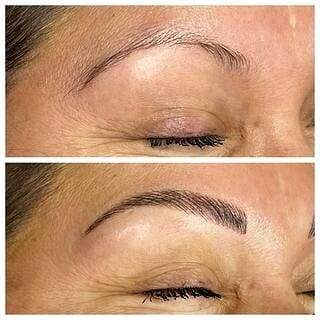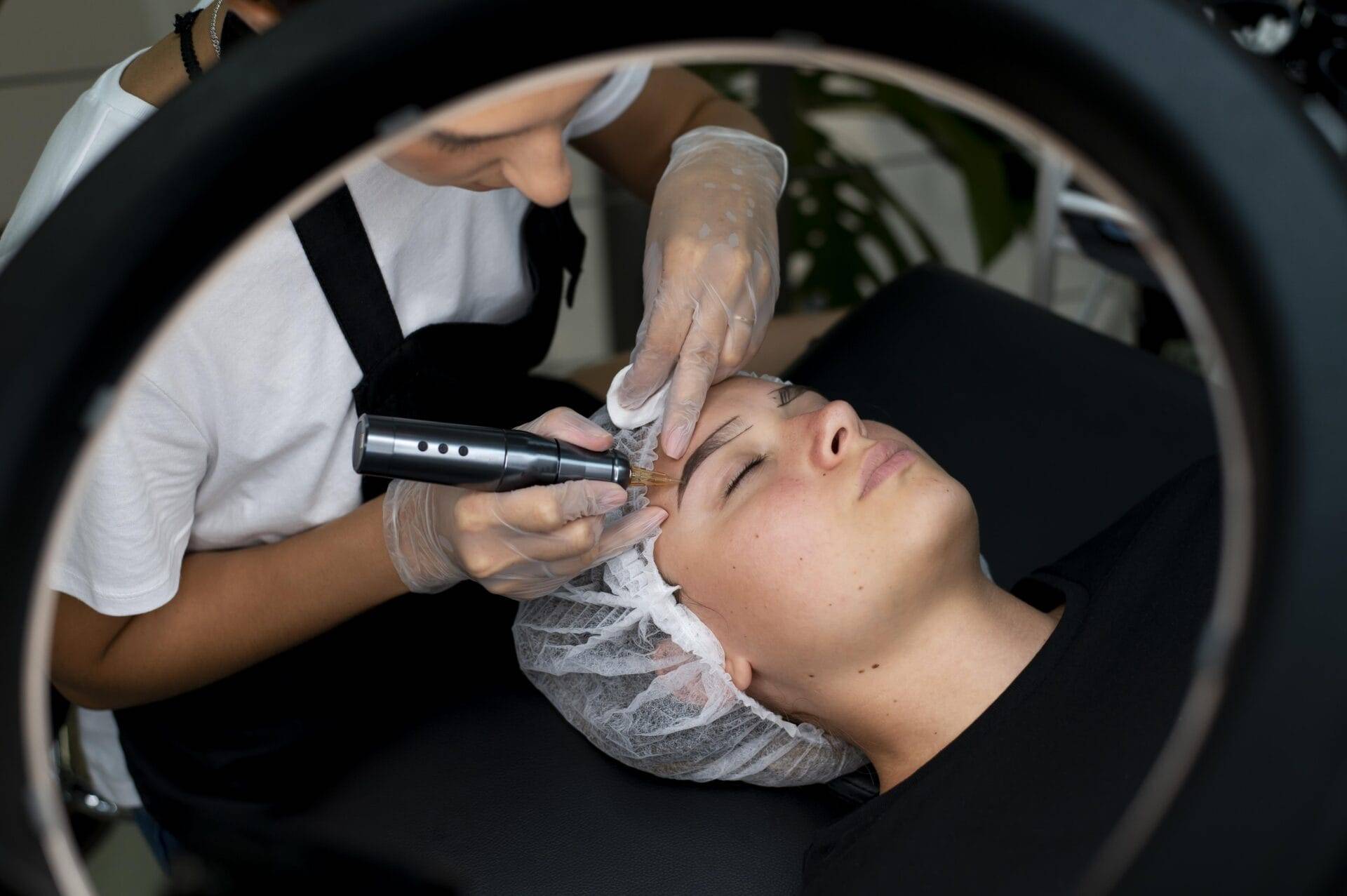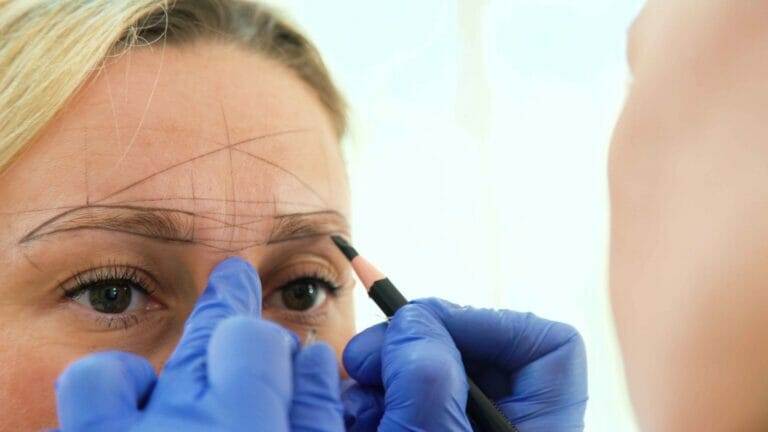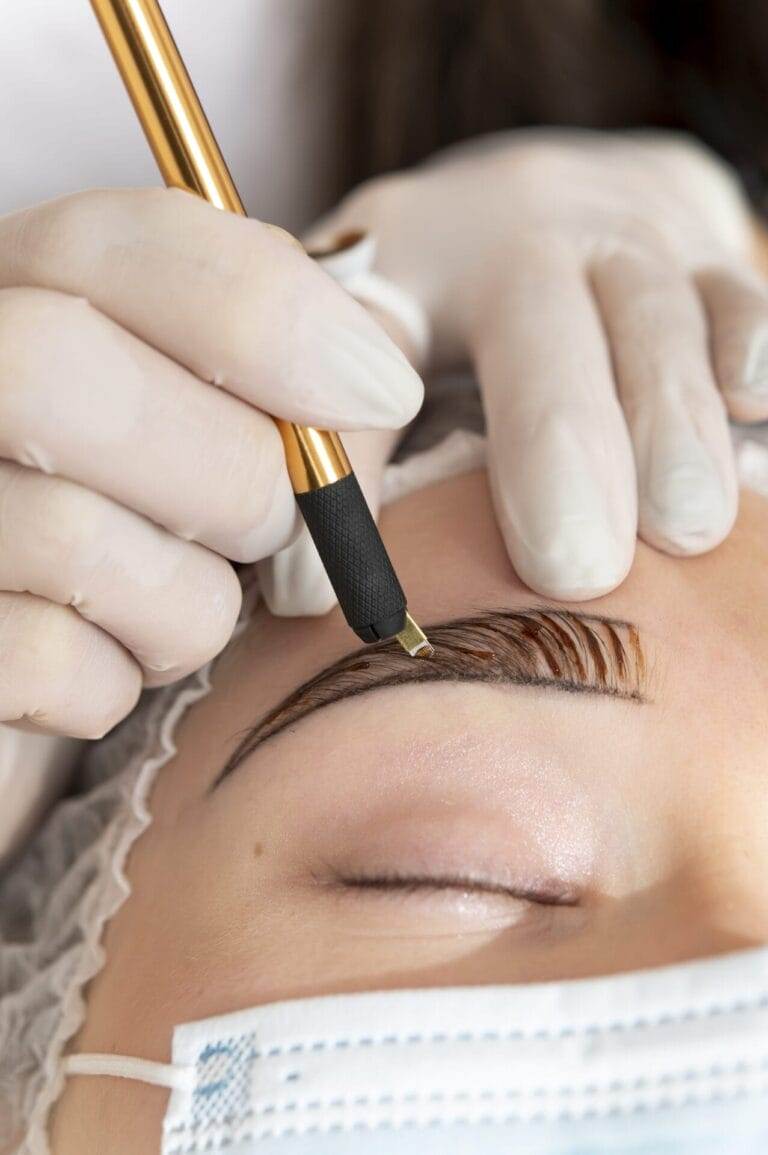Microblading has become increasingly popular in recent years as a way to achieve perfectly shaped and defined eyebrows. This semi-permanent makeup technique involves using a small handheld tool to create hair-like strokes on the skin, giving the appearance of natural brows. However, finding the right microblading artist is crucial to ensure that you achieve the desired results. With so many options available, it’s important to do your research and choose an artist who is skilled, experienced, and understands your individual needs.
What is Microblading and How Does it Work?
Microblading is a form of cosmetic tattooing that involves manually implanting pigment into the skin using a handheld tool with tiny needles. The process begins with a consultation where the artist will assess your natural brow shape, color, and desired outcome. They will then use a numbing cream to minimize any discomfort during the procedure.
Using the handheld tool, the artist will create small incisions in the skin and deposit pigment into these incisions, creating hair-like strokes that mimic the appearance of natural eyebrows. The strokes are carefully placed to enhance your natural brow shape and fill in any sparse areas.
The tools and materials used in microblading include a microblading pen or handheld tool, disposable microblades or needles, pigments, numbing cream, and aftercare products. It’s important to choose an artist who uses high-quality tools and pigments to ensure safe and long-lasting results.
The Benefits of Microblading: Why Choose this Procedure?
One of the main benefits of microblading is that it provides natural-looking results. The hair-like strokes created during the procedure blend seamlessly with your existing brow hairs, giving the appearance of fuller and more defined eyebrows. Unlike traditional eyebrow tattoos, which can look harsh and unnatural, microbladed brows are designed to mimic the look of real hair.
Microblading also saves time on your daily makeup routine. With perfectly shaped and filled-in brows, you no longer need to spend time filling in your eyebrows with pencils or powders. This can be especially beneficial for those with sparse or thinning brows, as microblading can create the illusion of fullness and save you time and effort in the morning.
Another advantage of microblading is its long-lasting effects. While the results vary from person to person, microbladed brows can last anywhere from one to three years with proper care and maintenance. This means you can enjoy beautiful brows without the need for frequent touch-ups or daily maintenance.
In addition to its aesthetic benefits, microblading can also boost your confidence and self-esteem. Many people feel more confident and put-together with well-groomed eyebrows, and microblading can help achieve this look. Whether you have naturally thin brows, have experienced hair loss due to medical conditions or treatments, or simply want to enhance your natural brows, microblading can give you the confidence boost you’ve been looking for.
Finding the Right Microblading Artist: Tips and Considerations
When it comes to finding the right microblading artist, it’s important to do your research and choose someone who is skilled, experienced, and reputable. Here are some tips and considerations to keep in mind:
1. Research potential artists: Start by researching microblading artists in your area. Look for artists who specialize in microblading and have a portfolio of their work available for you to view. This will give you an idea of their style and skill level.
2. Check for certifications and licenses: Ensure that the artist you choose is certified and licensed to perform microblading. This ensures that they have received proper training and adhere to health and safety standards.
3. Read reviews and testimonials: Look for reviews and testimonials from previous clients to get an idea of their experience with the artist. This can give you valuable insight into the artist’s professionalism, skill, and customer satisfaction.
4. Schedule a consultation: Before committing to a microblading appointment, schedule a consultation with the artist. This will give you the opportunity to discuss your desired outcome, ask any questions you may have, and assess whether you feel comfortable and confident in their abilities.
By taking the time to find the right microblading artist, you can ensure that you achieve the best possible results and have a positive experience throughout the process.
The Microblading Process: Step-by-Step Guide
The microblading process typically involves several steps to ensure that you achieve the desired results. Here is a step-by-step guide to what you can expect during your microblading appointment:
1. Preparing for the procedure: Before your appointment, it’s important to follow any pre-procedure instructions provided by your artist. This may include avoiding alcohol and caffeine, moisturizing your brows, and wearing comfortable clothing.
2. Numbing the area: To minimize any discomfort during the procedure, your artist will apply a numbing cream to the brow area. This will help ensure that you are as comfortable as possible throughout the process.
3. Mapping out the brows: Using a brow pencil or marker, your artist will map out the shape of your new brows. This involves measuring and marking key points on your face to ensure symmetry and balance.
4. Microblading the brows: Using a handheld tool with tiny needles, your artist will create hair-like strokes in the skin, depositing pigment into these incisions. The strokes are carefully placed to enhance your natural brow shape and fill in any sparse areas.
5. Applying aftercare products: Once the microblading is complete, your artist will apply aftercare products to help promote healing and protect the newly microbladed brows. This may include an ointment or balm that you will need to apply at home in the days following the procedure.
Following these steps, you will leave the appointment with beautifully microbladed brows that enhance your natural features.
Microblading Techniques: Different Styles and Effects
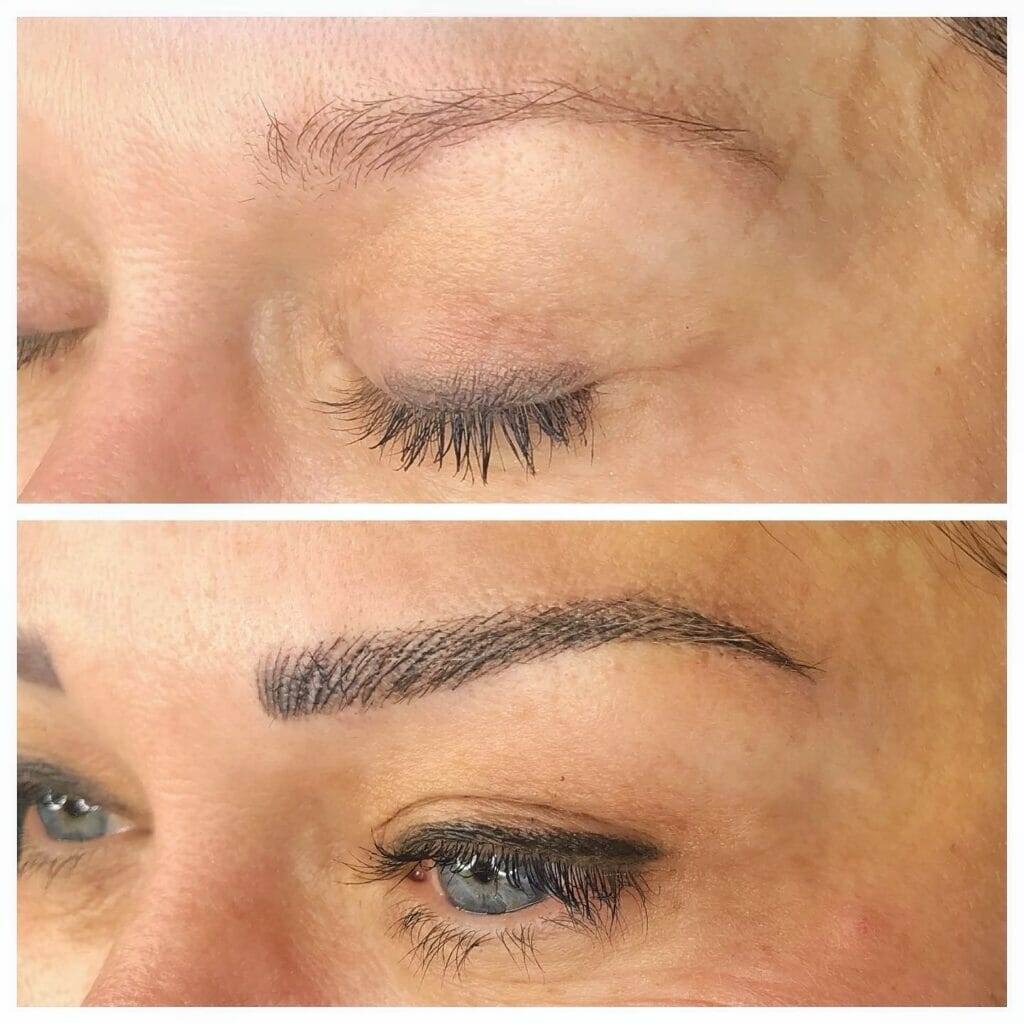
There are several microblading techniques that artists may use to achieve different styles and effects. Here are some of the most common techniques:
1. Feathering technique: Also known as the hairstroke technique, feathering involves creating fine, hair-like strokes that mimic the appearance of natural brow hairs. This technique is ideal for those with thin or sparse brows who want to achieve a natural-looking result.
2. Ombre technique: The ombre technique involves creating a gradient effect, with the front of the brows being lighter and gradually getting darker towards the tail. This technique is great for those who prefer a more defined and filled-in look.
3. Combination technique: As the name suggests, the combination technique combines both feathering and shading to create a more textured and defined brow. This technique is ideal for those who want a fuller and more defined look while still maintaining a natural appearance.
Each technique has its own unique effects on the brows, and it’s important to discuss your desired outcome with your artist to determine which technique is best suited for you.
Preparing for Your Microblading Appointment: Dos and Don’ts
To ensure the best possible results from your microblading appointment, there are certain things you should do and avoid in the days leading up to your appointment. Here are some dos and don’ts to keep in mind:
Dos:
– Avoid alcohol and caffeine for at least 24 hours before your appointment, as these can thin the blood and increase bleeding during the procedure.
– Moisturize your brows in the days leading up to your appointment to ensure that your skin is hydrated and in optimal condition.
– Wear comfortable clothing on the day of your appointment, as you may be lying down for an extended period of time.
Don’ts:
– Pluck or wax your brows in the weeks leading up to your appointment, as this can affect the shape and symmetry that your artist will be working with.
– Use retinol or exfoliating products on your brows in the days leading up to your appointment, as these can increase sensitivity and make the procedure more uncomfortable.
– Wear makeup on the day of your appointment, as this can interfere with the microblading process and affect the results.
By following these dos and don’ts, you can ensure that you are well-prepared for your microblading appointment and achieve the best possible results.
Aftercare Tips for Microblading: How to Take Care of Your Brows
Proper aftercare is crucial to ensure that your microbladed brows heal properly and retain their color and shape. Here are some aftercare tips to keep in mind:
– Avoid getting the brows wet for at least 24 hours after the procedure. This includes avoiding activities such as swimming, saunas, and hot showers.
– Apply aftercare products as instructed by your artist. This may include an ointment or balm that you will need to apply multiple times a day to keep the brows moisturized and protected.
– Avoid direct sunlight and sweating for at least a week after the procedure, as this can cause the pigment to fade or become discolored.
– Avoid picking or scratching the brows, as this can disrupt the healing process and affect the final results.
By following these aftercare tips, you can ensure that your microbladed brows heal properly and maintain their color and shape for as long as possible.
Microblading Results: What to Expect and How Long Does it Last?
After your microblading appointment, it’s important to understand what to expect in terms of initial results and the healing process. Here is what you can expect:
– Initial results and healing process: Immediately after the procedure, your brows may appear darker and more intense than desired. This is normal and part of the healing process. Over the next few days, the color will soften and the brows will begin to heal. It’s important to follow the aftercare instructions provided by your artist to ensure proper healing.
– Touch-up appointments: Microblading is a two-step process, and a touch-up appointment is typically scheduled 4-6 weeks after the initial procedure. This allows your artist to assess how the brows have healed and make any necessary adjustments or additions to achieve the desired results.
– Longevity of microblading results: The longevity of microblading results varies from person to person and depends on factors such as skin type, lifestyle, and aftercare. On average, microbladed brows can last anywhere from one to three years before a touch-up is needed. Regular touch-up appointments every 12-18 months can help maintain the color and shape of the brows.
By understanding what to expect and properly caring for your microbladed brows, you can enjoy long-lasting results that enhance your natural beauty.
Microblading vs. Other Brow Enhancement Options: Which is Right for You?
When it comes to enhancing your brows, there are several options available, including brow pencils, powders, tattoos, and microblading. Here are some factors to consider when choosing a brow enhancement option:
– Natural-looking results: If you want natural-looking results that mimic the appearance of real hair, microblading is often the best option. Brow pencils and powders can create a filled-in look but may not provide the same level of realism.
– Longevity: Microblading offers long-lasting results compared to other options such as brow pencils or powders, which need to be applied daily. While tattoos are also long-lasting, they can look harsh and unnatural.
– Customization: Microblading allows for customization and tailoring the brows to your individual needs and preferences. This is not always possible with other options, which may have limited color or shape options.
– Maintenance: Microbladed brows require minimal maintenance compared to other options. Once the initial healing process is complete, you can enjoy beautiful brows without the need for daily application or touch-ups.
By considering these factors, you can determine which brow enhancement option is right for you and achieve the desired results.
Frequently Asked Questions About Microblading: Answered
Here are some common questions about microblading answered:
Q: Does microblading hurt?
A: The level of discomfort during microblading varies from person to person. Most people experience mild discomfort or a scratching sensation during the procedure. Numbing cream is applied before the procedure to minimize any discomfort.
Q: How long does the microblading procedure take?
A: The microblading procedure typically takes around 2-3 hours, including the consultation and mapping out of the brows.
Q: Can I wear makeup after microblading?
A: It’s best to avoid wearing makeup on the brows for at least a week after the procedure to allow them to heal properly. Once they are fully healed, you can resume wearing makeup as desired.
Q: Can I still pluck or wax my brows after microblading?
A: It’s best to avoid plucking or waxing your brows in the weeks leading up to your microblading appointment and during the healing process. Once they are fully healed, you can resume your regular brow maintenance routine.
For more information about microblading and to have your specific questions answered, it’s best to consult with a qualified microblading artist.
Microblading is a popular and effective way to achieve perfectly shaped and defined eyebrows. By finding the right microblading artist and following proper aftercare, you can enjoy natural-looking and long-lasting results. Whether you have naturally thin brows, have experienced hair loss, or simply want to enhance your natural brows, microblading can provide the confidence boost you’ve been looking for. Consider microblading as a brow enhancement option and consult with a qualified artist to determine if it’s the right choice for you.
If you’re interested in exploring other forms of self-expression through body modifications, you might want to check out this article on the growing popularity of piercings and its positive impact on self-expression. It delves into the various types of piercings and how they can be a powerful way to express your individuality. Read more

